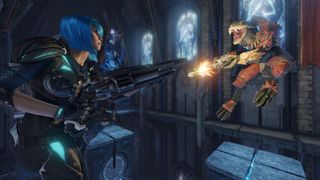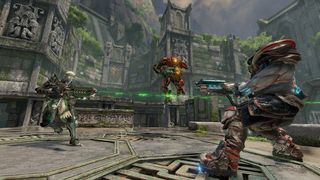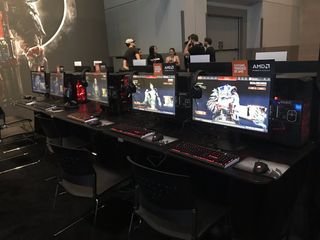Don't worry, Quake Champions is still Quake
We've played Quake Champions at PAX East. Read our verdict.

Having not played a Quake game in quite some time, it was with mild trepidation that I approached the Quake Champions booth at PAX East 2017. My worries melted away as I let my lithe, blue-haired champion loose on the map, zipping around a bit aimlessly at first, I admit, but completely absorbed in the fast-paced thrill of it all, thirsty for more by the end of the brief demo.
My sampling of the game, in 5v5 team deathmatch, was set beneath the gothic ceilings of the Blood Covenant map, a callback of sorts to the 'Campgrounds' map from Quake III. Before the game tosses you into the firefight, though, you’ll get to choose your Champion, a controversial change to Quake that shakes up the classic formula.
Each hero has their own special ability—Nyx, my Champion, can wallrun and ghostwalk, rendering her invisible and invincible, which makes for some sneaky moments with the shotgun. Other characters, like the Ranger, likely the default hero, will make traditionalists feel right at home. The Ranger can toss his Dire Orb, and then teleport to that point, a bit like Unreal Tournament's Translocator. These characters also have unique stats—HP, speed, and armor—that distinguish them.
While the Champions may be divisive, with fears that they could potentially take away from the core Quake experience that focuses purely on skill, I felt that the unique characters made a pretty minimal impact. The Champions’ abilities are more of an afterthought. It’s fun to experiment with your Champion’s offensive and defensive strategies, for sure. I enjoy being able to ghostwalk and blow up my enemies just as much as using the same skill to flee what would have otherwise been a losing fight. At the same time, though, this is still very much a game of scrambling for weapons upgrades and armor with twitchy skills.
“...We wanted to make [the champion abilities] additive to the experience, not replacing the experience,” Quake Champions creative director, Tim Willits, told me following my time with the game. “We feel that it's a good bridge between our hardcore Quake fans that would murder us if we messed with the formula,” Willits half-joked, “but it also has something that is new and a little bit more modern.”
If you’re looking for a hero shooter like Overwatch, you'll probably be disappointed. Each Champion is well designed, but they lack a distinct voice or personality. Unlike Blizzard's breakout FPS, where regular back-and-forth between Heroes subtly breathes life into the game, Quake’s Champions are silent vessels for you to perform some impressive gunslinging. Which is probably what hardcore Quake players prefer.
While the Champions may feel new, the weapons are all classic Quake, but they fit the modern mold quite well. Id Software was quite deliberate in making sure that 'the holy trinity' of weapons—the railgun, rocket launcher, and lightning gun—was preserved, and they’re all still entirely skill-based—your champion has no impact on how well you use a gun.
Comic deals, prizes and latest news
Sign up to get the best content of the week, and great gaming deals, as picked by the editors.
The Champions’ abilities are more of an afterthought.
These weapons felt quite familiar in my grasp, with tactile, responsive animations that made me feel like I was stirring up havoc. There are no loadouts, and you’re free to carry as many weapons as you like. The only challenge lies in beating your enemies to weapon spawn points.
The verticality of the maps, along with the narrow tunnels and cloisters scattered throughout the Blood Covenant cathedral, demand a versatile arsenal. I delighted in spraying my enemies with machine gun bullets, leaping in the map’s open, cavernous halls, before switching to my shotgun as I got up close and personal with my opponents on a tight staircase. The railgun, meanwhile, is still a favorite, and can be used to great effect in cramped hallways and stairwells, at least within the Blood Covenant map I was playing in.

Dashing into a strange new map can present its own set of challenges, but the Blood Covenant map was a joy to explore, even as I was still learning the spawn points. The map is essentially a gothic cathedral that’s been twisted for some dark purpose, judging by the ominous blood pooled in the church’s central nave. Light sparkles through stained glass windows, and the vaulted ceilings create lots of headroom. Jump pads scattered throughout allow you to spring high into the air to shoot at unwitting enemies below.
You can then make a quick escape by jumping across crumbling pillars that form a precarious bridge to other towering haunts. Alternatively, you can plunge into the Covenant’s dark cellars, which make for some excellent sneaking, though that strategy can turn on your quickly if you’re caught by surprise. The map isn’t so big that it takes you hours to learn its finer details—by the time I was finished with my 20 minute match, I felt as though I had a good feel for many of the map’s nuances.

All of that frantic combat runs like butter on the AMD system I was playing on, too. The PC I played on was running a new Ryzen 7 1800x CPU, an XFX RX 480 GPU (8GB), 16GB RAM, and an Aorus GA-AX370 motherboard. Willits suggested that the red fan lights help make the game run faster, though I have my doubts.
It’s not easy modernizing a legendary game that many hold so dear. It’s a fine line to walk, but Id has taken on the challenge with a good deal of optimism, especially following the success of Doom. Willits noted, “Doom, as a studio, really helped make this game way easier, because people saw what the studio did with Doom and they were like, 'Okay, yeah, at its core it's that energy and excitement, but there are some cool new things.’"
That’s absolutely the sense I got walking away from Quake Champions today. Though we might mourn the absence of classic, stripped-down Quake, it's worth remembering that Quake Live wasn't a resounding success. Id aims to bring Quake to the forefront amongst other modern shooters, and does so with aplomb while maintaining Quake’s core identity. Willits described a chain of progression loops to draw in new players, giving them incentive to hone their fledgling skills.
“We want new players to pick that one Champion that they like and then work on some of the rewards and some of our challenges are quite easy, like get 10 kills with a rocket launcher. You can do that,” Willits explained. “And I feel like if you can deliver little successes to players, they can build on those successes until they feel more comfortable.
Quake Champions promises support for its competitive players, with ranked matches that group teams of similar skill. Instead of tossing vulnerable players into what Willits calls a “free-for-all bloodbath”, they can try out their newfound skills on even footing. It’s a key step toward Quake finding a new audience as it tries to uphold its legacy.
Most Popular


